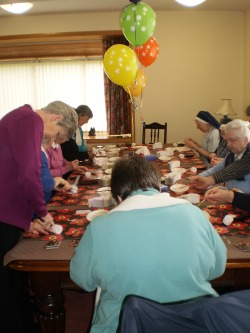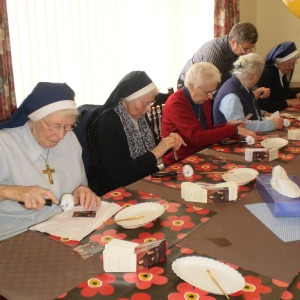
 Over the past few months many people have been receiving the new ‘Mary Aikenhead Relic Prayer Cards’ available from the Congregation. One wonders how many stop to think about the process it took to get the card to them and more surprisingly do they realise that a Sister of Charity has been praying for them for many weeks beforehand!
Over the past few months many people have been receiving the new ‘Mary Aikenhead Relic Prayer Cards’ available from the Congregation. One wonders how many stop to think about the process it took to get the card to them and more surprisingly do they realise that a Sister of Charity has been praying for them for many weeks beforehand!
Here Sr Josephine McDonald, the vice-Postulator for the Cause of Mary Aikenhead, tells us about the process that has taken place to get the cards ready. A process that culminated in a ‘Relic Working Party’!
“As our current novena cards to Mary Aikenhead were running out last year, the Resource Group Committee for the Cause thought it would be good, when reprinting, to have a relic of Mary Aikenhead on the card and a piece of her coffin would be used. When the prayer cards were printed the relic had to be attached and then the card folded over and sealed securely. All of this had to be done by hand. Although the printer had a few people ready to do this it proved to be a very slow process. It became clear that help was needed.
Twenty Sisters were asked and willingly agreed to help attach the relic. A few sisters, who were told they could be listening to the radio or CD while on the job, said they would prefer quietness so that they could pray for whatever person will use that particular relic prayer card.
 When about half of these prayer cards were completed volunteers were asked to gather in Caritas, Sandymount, on Saturday 3rd May for the final stage of sealing them. Twenty-two Sisters turned up and we found a place set for each one with an oil cloth table mat, small roller, water, a little brush, tissues and of course bundles of the relic prayer cards ready for the final stage. We were given a lesson by Mr Dermot O’Connor, the printer, and then got to work.
When about half of these prayer cards were completed volunteers were asked to gather in Caritas, Sandymount, on Saturday 3rd May for the final stage of sealing them. Twenty-two Sisters turned up and we found a place set for each one with an oil cloth table mat, small roller, water, a little brush, tissues and of course bundles of the relic prayer cards ready for the final stage. We were given a lesson by Mr Dermot O’Connor, the printer, and then got to work.
It was a special afternoon in many ways. There was chat and fun and laughter, news was shared and of course stories from our own early days remembered. But there was also much work done in a very relaxed atmosphere. The completed cards were collected regularly from the tables and sorted into bundles. The time frame for the afternoon was to be from 3:00 to 5:00pm. We were given regular count downs and at 5:00pm we closed down on the task set for the afternoon.
 Sr Patricia Lenihan, the ‘party planner’, thanked us all and told us we were each going to be given a ‘party bag’ as we left Caritas. This bag contained about 300 cards that needed to be sealed, which meant that we were also to take with us our table mat, roller and brush which were all required for the task.
Sr Patricia Lenihan, the ‘party planner’, thanked us all and told us we were each going to be given a ‘party bag’ as we left Caritas. This bag contained about 300 cards that needed to be sealed, which meant that we were also to take with us our table mat, roller and brush which were all required for the task.
Then she invited us to the dining room where Sr. Mary Christian had prepared a delicious tea ~ a totally unexpected and pleasant surprise and a very welcome one too as everyone was in need of nourishment at that stage. Amid banter and chat and fun we really enjoyed a beautiful tea followed by dessert.
It was an afternoon with a difference focussed as it was on Mary Aikenhead and her clients. It was also a sacred afternoon, one of loving service, which all who came will remember.
The History of Relic Prayer Cards
The veneration of relics is a strong and ancient Catholic Tradition with roots going back to the Old Testament when the Jewish prayer shawl, with its tassels, was considered as having a sacred significance and power.
In Luke’s gospel chapter 8, we read the moving story of ‘a woman afflicted with a haemorrhage for 12 years … came up behind Jesus and touched the tassel of his cloak.’ She was healed. Her faith was not in some magical power of the tassel but in the Messiah who wore it. It is significant that Jesus asked ‘Who touched me?’ and not ‘Who touched the tassel of my cloak?’ So the tassel was virtually synonymous with Jesus himself. When the woman touched it, Jesus was ‘aware at once that power had gone out from him…’ Then the woman came forward out of the crowd. Jesus said to her ‘Daughter, your faith {in me} has saved you. Go in peace and be cured of your affliction.’
 It all sounds very similar to our understanding of the function of Christian relics as sacramental. Relics can be associated with favours received including healings, when used with faith in God who responds to the saintly person’s intercession.
It all sounds very similar to our understanding of the function of Christian relics as sacramental. Relics can be associated with favours received including healings, when used with faith in God who responds to the saintly person’s intercession.
The first evidence of the use of a relic of Mary Aikenhead dates back to the late 1860’s when a piece of her clothing was applied to a child with a very severe eye problem. The child was cured and the planned surgery not required.
In the 1940’s, when Sister Madeleine Sophie Bergin was looking after the Cause, relics of Mary Aikenhead became more widespread. Those used were small pieces of linen which had touched her coffin. Later a small piece of the actual coffin was used. This became available after her body was exhumed and re-coffined in 1923. These early relics were made up mainly by our elderly Sisters. It was a beautiful and special task.
The veneration of relics is a practice that reminds Catholics of the goodness and power of God who chooses to work through humanity. So I believe that Mary Aikenhead was present with us on that Saturday at the ‘Relic Working Party’. May she also be there for all who will use these relics and make their needs known to God through her powerful intercession.”







